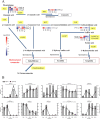Transcriptomic profiling of Melilotus albus near-isogenic lines contrasting for coumarin content
- PMID: 28676637
- PMCID: PMC5496894
- DOI: 10.1038/s41598-017-04111-y
Transcriptomic profiling of Melilotus albus near-isogenic lines contrasting for coumarin content
Abstract
Coumarin and its derivatives are widely used as fragrances in industrial products and have medical value. The goal of the present study was to discover genes and pathways related to coumarin biosynthesis in Melilotus albus using transcriptome analysis. The genes of five M. albus near-isogenic lines (NILs) that had different coumarin content and β-glucosidase activity according to the investigation of pedigree were quantified and then analysed by RNA-Seq. Using transcriptome analysis, differentially expressed genes (DEGs) were identified in two pairwise comparisons that differed in coumarin content as well as in two pairwise comparisons that differed in β-glucosidase activity. Gene expression pattern analysis suggested similar transcriptional trends in the genotypes with the same coumarin levels. Furthermore, the Kyoto Encyclopedia of Genes and Genomes (KEGG) database of DEGs was used to identify functional pathways associated with coumarin biosynthesis. We identified 111 unigenes, with several DEGs among them possibly being related to coumarin synthesis pathways. Unigenes encoding a hexokinase, an abscisic acid receptor, a phenylalanine ammonia-lyase (PAL) and two peroxidases particularly showed correspondence with the coumarin content of different genotypes. These results will contribute to a better understanding of the coumarin biosynthesis in M. albus.
Conflict of interest statement
The authors declare that they have no competing interests.
Figures






References
-
- Smith WK, Gorz HJ. Sweetclover improvement. Adv. Agron. 1965;17:63–231.
-
- Stevenson GA. An agronomic and taxonomic review of the genus Melilotus Mill. Can. J. Plant Sci. 1969;49:1–20. doi: 10.4141/cjps69-001. - DOI
-
- Maddaloni J. Forage production on saline and alkaline soils in the humid region of Argentina. Reclam Reveg Res. 1986;5:11–16.
-
- Stickler FC, Johnson IJ. Dry matter and nitrogen production of legumes and legume associations in the fall of the seeding year. Agron. J. 1959;51:135–137. doi: 10.2134/agronj1959.00021962005100030004x. - DOI
-
- Allen, O. N. & Allen, E. K. The Leguminosae: A source book of characteristics, uses and nodulation. Madison: The University of Wisconsin Press (1981).
Publication types
MeSH terms
Substances
LinkOut - more resources
Full Text Sources
Other Literature Sources

